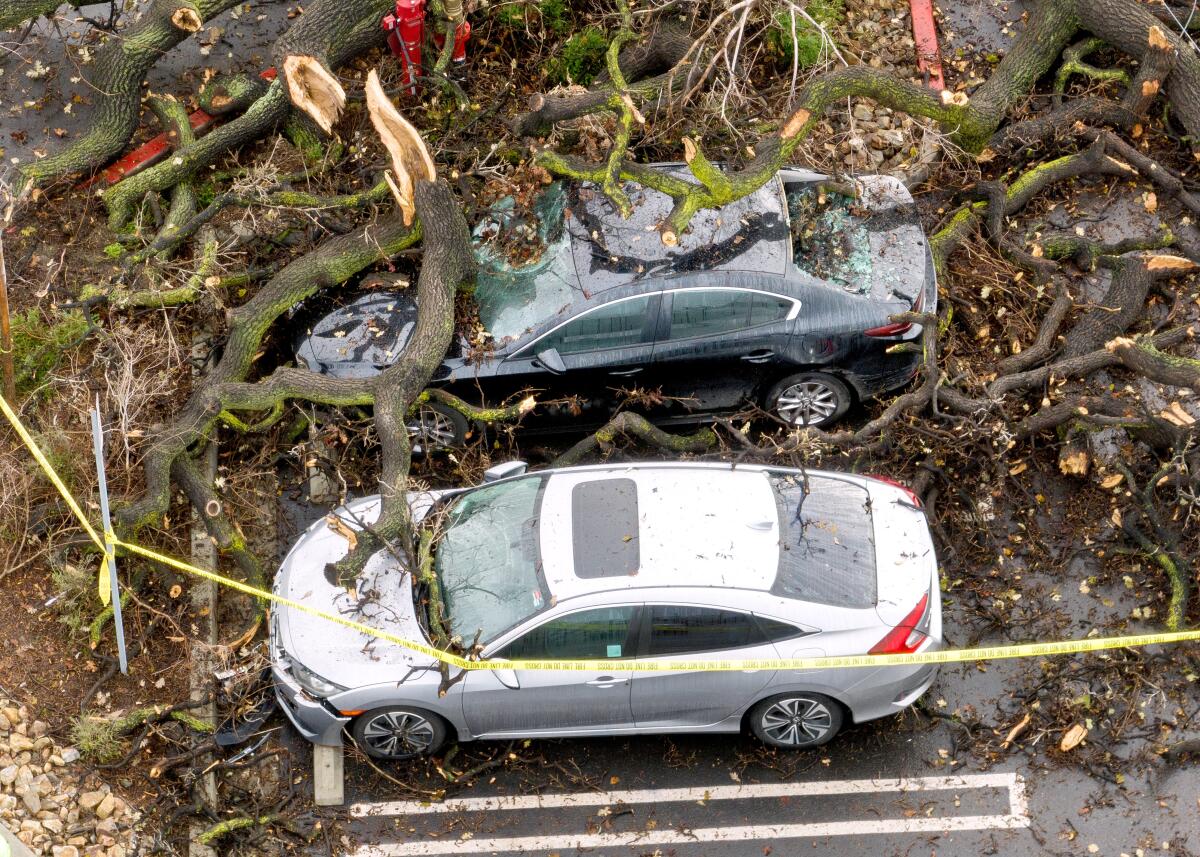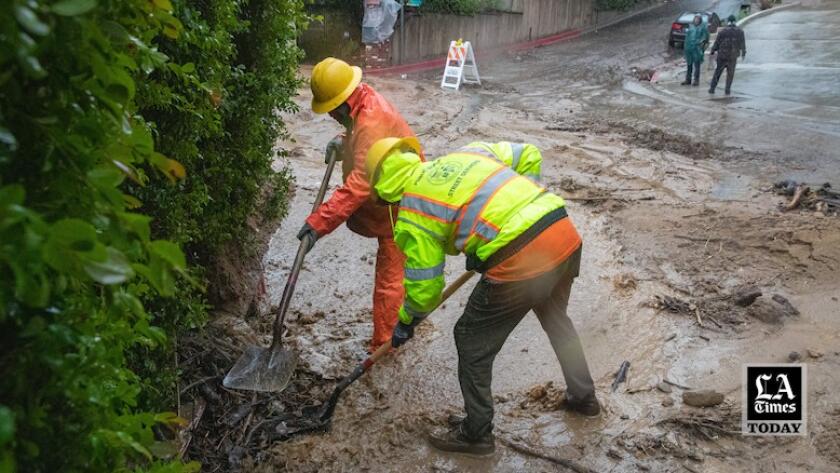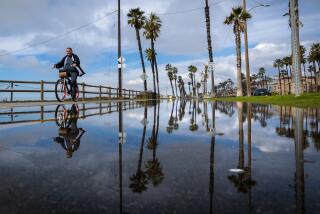500 mudslides, flooded communities, broken bridges: California faces long, costly storm recovery

MERCED, Calif. â A pier in Santa Cruz split in half. Extensive flooding in Soquel Village, Capitola and Planada. Vital bridges badly battered or closed. More than 500 reported mudslides across California in the last few weeks, including some that damaged homes and cars in L.A. hillside communities.
The atmospheric river storms that pummeled California for weeks inflicted âextensiveâ damage to as many as 40 of the stateâs 58 counties, and total repairs could reach as much as $1 billion, according to authorities.
The estimated cost is likely to change as teams of local, state and federal officials on Saturday began damage assessment that is expected to continue for several weeks, according to Brian Ferguson, a spokesperson for the Governorâs Office of Emergency Services.
President Biden on Saturday approved an Expedited Major Disaster Declaration, ordering federal aid to be provided to recovery efforts in areas of California that were affected by the storms. All 58 counties are able to access hazard mitigation assistance, meaning the federal aid can be given to state and local governments and specific nonprofits to reduce risk to life and property.
Federal assistance will reimburse local and state governments for 75% of the cost to repair infrastructure and other necessities. It will also provide assistance for individual programs based on need and how much insurance residents have, according to Ferguson. The local governments for the most damaged areas could pay as little as 8.5% of the cost.
In Merced, Sacramento and Santa Cruz counties, residents will have access to assistance to replace or repair damaged property and other services; nonprofit organizations in those counties will receive federal aid to provide emergency work and debris removal.
The storms, which began after Christmas and continued until this week, dumped rain across the state, resulting in the deaths of at least 20 people, prompting evacuations and flooding rivers and roadways.
The storms brought âsignificantâ damage to Merced, Sacramento and Santa Cruz counties, as well as Monterey, Santa Barbara, Ventura and San Benito along the Central Coast, Ferguson said, adding that there will be âextensiveâ costs for 30 to 40 counties.
As of Monday, the U.S. Geological Survey had mapped out more than 500 landslides across the state since Dec. 30, piles of dirt and rocks blocking roads and power outages due to fallen trees.
In Monterey County, the Gonzales River Bridge was weakened by flooding and was too damaged to use Tuesday, according to officials. The bridge was blocked with cement rails; it will take two to three weeks before the next steps for repair can be determined. Additionally, over the weekend, a rock slide covered portions of Highway 1 in Big Sur, and the roadway showed âsignificant instabilityâ after the storms, according to Caltrans.
In Ventura County, piles of rock and mud on roadways reached as high as 40 feet, isolating residents and blocking travel, according to the Sheriffâs Office. Authorities said it could take up to three weeks to clear one single-lane access road and up to six months to make repairs.
If more counties are found to have significant damage from the storms, they could be added to the disaster declaration, Ferguson said.
âThere are thresholds we need to meet with the Federal Emergency Management Agency to be able to access that,â he added. âOur goal is [to] maximize the federal support we can bring to communities.â
In Monterey County alone, a preliminary damage assessment was at $80 million, according to spokesperson Nicholas Pasculli. That cost would include debris removal, emergency protective measures and equipment, plus repairs to public utilities, roads, bridges, water control facilities, public buildings and parks and recreation facilities.
Pasculli said he expects that number to climb to at least $100 million Tuesday, once the county receives the latest information.
The Monterey County agriculture industry sustained losses of $40 million to $50 million, and 25,000 to 35,000 acres of agricultural land were âseriously impactedâ by floods, Pasculli said. There were also losses to equipment, irrigation systems, well pumps and crops.
There was at least $30 million to $50 million in infrastructure damage throughout the county, including roads, bridges and other buildings.
In Sacramento County, it could cost more than $123.8 million to make repairs, but that figure is expected to âcome downâ after officials finish their inspections, according to spokesperson Samantha Mott. As of Tuesday, the storms had caused about $668,000 in damage to private property, including homes, businesses and outbuildings, Mott said.
In Santa Cruz County, the estimate as of Friday was $55 million, and spokesperson Jason Hoppin called that a âpretty dramatic understatement.â
âThat number is going to [go] up exponentially,â he said. âItâs a fraction of what the final number will be.â
Hoppin said the figure does not include private property, Caltrans infrastructure or state roads. Damage assessment, he said, is ongoing.
âWhen you get rain every day, you canât assess things,â Hoppin said, noting that Tuesday was the first sunny day in weeks. âWe have roads that are still evolving in terms of degradation.â
In Ventura County, there was more than $30 million in damage to public property, according to Patrick Maynard, director of the Sheriffâs Office of Emergency Services. More than 80 private properties were affected, including two destroyed structures, he said, adding that Ventura should have an updated damage assessment later this week.
Mike North, a spokesman for Merced County, didnât have a damage estimate, as the assessment is ongoing, but said the agricultural sector was hit hardest financially.
âThis has, however, impacted most sectors of our economy,â he added.
Another storm system is expected to drop from the Pacific Northwest into California this week but wonât result in significant rainfall, according to National Weather Service meteorologist David Sweet. The Bay Area is forecast to get up to half an inch of rain, primarily in portions of Sonoma and Napa counties, on Wednesday. The Los Angeles region could see drizzle or light showers early Thursday.
âThe ground is saturated, so additional rainfall would lead to a very rapid response of water running in the rivers, and there would be some hydrological issues going on, because we are very close to saturation now,â he added.
Saturdayâs storm set a rainfall record of 1.82 inches in downtown Los Angeles, smashing the old record of 1.56, set in 1978, Sweet said. At the Long Beach Airport, there were 1.72 inches, passing the 1978 record of 1.48. Records were also broken Saturday in Camarillo and Paso Robles.
So far this water year, which began Oct. 1, downtown L.A. has received 13.01 inches of rain. The typical figure for this point in the year is 5.67 inches.
âThe storms that we had over the past couple of weeks had an atmospheric river for each one, and those storms are the ones that tend to supply the West Coast [with] most of its rainfall during the winter season,â Sweet said. âIt was a little bit unusual to see so many atmospheric rivers lined up like this.â
He characterized the rainfall totals in Santa Barbara County as especially impressive.
âOn average, one would expect that kind of rainfall once every 100 years,â Sweet said. âThat doesnât mean it takes another 100 years for another storm to occur, but typically with average statistics for that area, you would only expect something like that to occur once every 100 years.â
The storms improved Californiaâs drought conditions, eradicating the two most severe categories, âextremeâ and âexceptional,â for the majority of the state, according to the U.S. Drought Monitor. On Dec. 27, about 7.16% of California was considered to be in âexceptionalâ drought; as of Jan. 10, none of the state was in that classification.
Despite the deluge, Sweet said, if the state were to be dry for the remainder of the water year, like it was last year, hillside vegetation could dry out, making for a potentially dangerous wildfire season this summer.
âTypically, if we donât get our rainfall in January through March, we can be in for a busy fire season,â he noted. âBy the time July and August rolls around, things have dried out.â
Watch L.A. Times Today at 7 p.m. on Spectrum News 1 on Channel 1 or live stream on the Spectrum News App. Palos Verdes Peninsula and Orange County viewers can watch on Cox Systems on channel 99.
More to Read
Sign up for Essential California
The most important California stories and recommendations in your inbox every morning.
You may occasionally receive promotional content from the Los Angeles Times.












